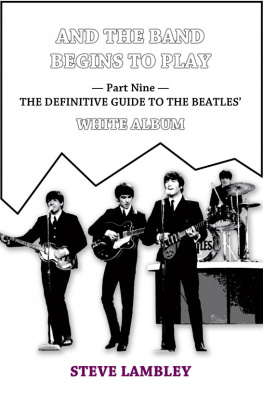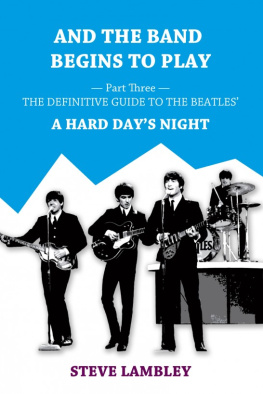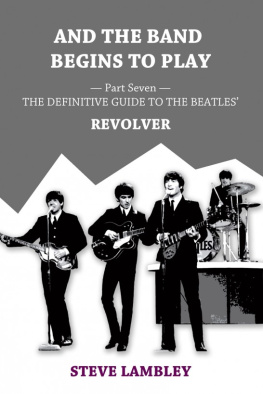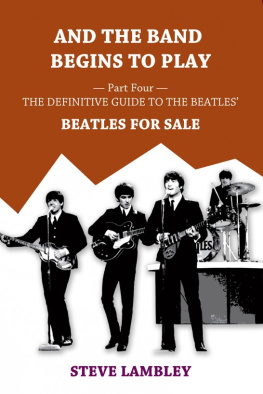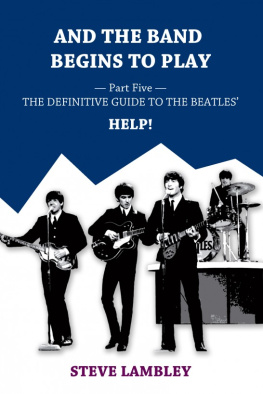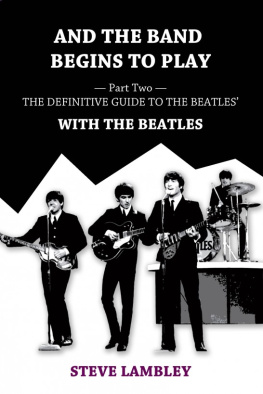AND THE BANDBEGINS TO PLAY
Part Ten The Definitive Guide to the Beatles YELLOWSUBMARINE
by
SteveLambley
Published bySLIDE Books
Version 2.0
Steve Lambley2015
All song lyricsremain the copyright of their respective owners, and are quoted forthe purposes of scholarship, under fair dealing and fair usagelaws. No infringement is intended.
No part of thisbook may be reproduced in any form without written permission fromthe copyright holder.
SmashwordsEdition, Licence Notes
This ebook islicensed for your personal enjoyment only. This ebook may not bere-sold or given away to other people. If you would like to sharethis book with another person, please purchase an additional copyfor each recipient. If youre reading this book and did notpurchase it, or it was not purchased for your use only, then pleasereturn to Smashwords.com and purchase your own copy. Thank you forrespecting the hard work of this author.
Table of Contents
Yellow Submarine LP
ApplePMC/PCS 7070 Released 17 January 1969
Brian Epsteinhad signed a three-picture deal with United Artists in 1964, butafter A Hard Days Night and Help!, the groupsenthusiasm for making a third movie seemed, quite naturally, totake a back seat to the likes of Sgt Pepper and Apple. Therewas, of course, no shortage of script proposals, including thecomedy western A Talent For Loving, a front-runner for muchof 1965 and which Walter Shenson finally produced in 1969 starringRichard Widmark. However, one of the most unlikely proposals camefrom the pen of Joe Orton. Given Ortons reputation as the writerof the notorious Entertaining Mr Sloane and Loot, itis in many ways surprising that negotiations got as far as theydid. However, Paul was a fan of Ortons work, and was a backer forthe original production of Loot, and John would certainlynot be deterred from being involved in a project just because itmight affect his public image. And so, Orton submitted hisscreenplay Up Against It a gay-themed comedy in which, ashe wrote in his diary, the boys have been caught in-flagrante,become involved in dubious political activity, dressed as women,committed murder, been put in prison and committed adultery onlyto have it returned by Brian Epsteins office without so much as acovering letter. Orton was still working to develop the scriptwhen, on 9 August 1967, he was killed by his lover KennethHalliwell, who then committed suicide.
Fortunately,resolution to the Beatles dilemma came with a project spearheadedby Hungarian-born television producer Al Brodax, creator of the ABCcartoon series, The Beatles. With Canadian animator GeorgeDunning as director and Czech-born Heinz Edelmann as art director,Brodax was tasked with producing the full-length film in less thana year. It was agreed the Beatles would provide three new songs( though the film eventuallybagged four) , and that the film would use up to a dozensongs from the groups back catalogue. The script was fashioned bya team of writers, including Harvard Professor of Greek and Latinliterature Erich Segal, who received a credit for his work, andLiverpool poet Roger McGough, a member of the Scaffold alongsidePauls brother Mike McGear, who didnt.
The Beatleswere initially less than enthusiastic about the project, beingsceptical about the appeal the film would have to their maturingaudience. Scepticism not helped by the fact that the producers,King Features, were best known for the Popeye cartoon strips. (Paulfelt they were nice enough but artistically we werent thatimpressed.) The group were, however, not slow to offer suggestionsfor the script. Paul discussed broadening out the title song toinclude a commune of different coloured submarines, which appearbriefly in the credit sequence. John was later to claim, with adegree of hyperbole, that he was responsible for half the filmsideas. You know the idea for the hoover? The machine that suckspeople up? All those were my ideas. They used to come to the studioand sort of chat Hi John, old bean. Got any ideas for the film?And Id just spout out all this stuff, and they went off and didit. Brodax himself recalls that John called him up in the middleof the night with the thought wouldnt it be great if Ringo wasfollowed down the street by a yellow submarine? an image thatmade it into an early sequence. But its hard to differentiatebetween direct and indirect input from the group. From thenarrators very first line Once upon a time or maybe twice the script is very Lennonesque, but most of the films Liverpoolhumour seems to have come from Roger McGough. And surely John andYokos first meeting in 1966 inspired the prominent YES blocks,but its not clear whether this idea was actually suggested byJohn.
Musically,however, the Beatles were reluctant to make any great efforts onbehalf of the contractual obligation project, and the filmsnew material was recorded over a 12-month period, consisting ofsongs considered not good enough for whatever project was beingworked on at the time. According to George Martin, If they had anyrubbish, as they considered it, at the end of a session, that wouldbe one of the songs. There used to be a standing joke: Ah, goodenough for Yellow Submarine let them have thatone. Of course, when Yellow Submarine became a big success,it was a different story.
Even thirtyyears later, the groups lack of enthusiasm for the musical side ofthe Yellow Submarine project subconsciously bubbles up theone glaring error in Pauls memoir Many Years From Now,written by Barry Miles, was tooverlook half of the films new material: YellowSubmarine only had two new tracks on it: Pauls All TogetherNow and Johns Hey Bulldog. George summed up his feelings: Thething I liked most about the movie was that we didnt really haveanything to do with it.
And so the bestof the films songs are undoubtedly the handful of vintage tracks.The title song is taken from Revolver, which was releasedtwo and a half years previously. Older still is Nowhere Man,which is arbitrarily shoehorned into the narrative with commendableaudacity.
Nevertheless,the film was enthusiastically received by the public, and by manycritics. Pauline Kael of The New Yorker summed up theresponse in her own inimitable way: From the nursery to theboutique is now a very short path; Yellow Submarine travelsit with charm and ease.

But then camethe problem of how to release a record package to tie in with thefilm that would contain just four new songs. The natural solutionwould be an EP, but that format was not at all popular in the US,meaning that a Magical Mystery Tour-type compromise wouldhave to be found there anyway. And so the curious YellowSubmarine album came to be, with Side One comprising the fournew songs, together, naturally, with Yellow Submarine, and,rather less naturally, All You Need Is Love. Side Two would begiven over to George Martin, and selections from the orchestralsoundtrack. Again, not an ideal solution as far as the Beatles wereconcerned they were annoyed when the US release of Help!was peppered, as it were, with exclusive instrumental music fromthe pictures soundtrack.
On the plusside, however, George Martin would benefit hugely from a tidal waveof royalties which the group must have found preferable to KenThorne riding on their success with his musical interludes onHelp! So Yellow Submarine was a curious concoction oftracks, and not the best value offering for Beatle fans, with eventhe newest of the songs on the album being nearly a year old.
Next page
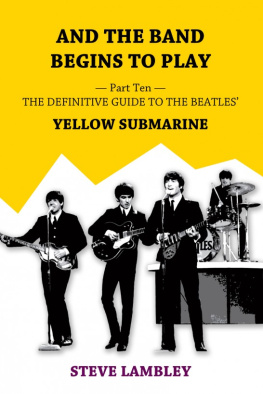
![Lambley - And the Band Begins to Play: [Part9 The Definitive Guide to the Beatles White Album]](/uploads/posts/book/213743/thumbs/lambley-and-the-band-begins-to-play-part9-the.jpg)
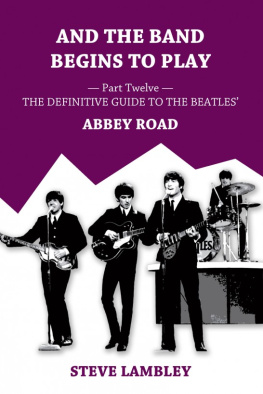
![Lambley - And the Band Begins to Play: [Part1 The Definitive Guide to the Beatles Please Please Me]](/uploads/posts/book/213741/thumbs/lambley-and-the-band-begins-to-play-part1-the.jpg)


![Lambley - And the Band Begins to Play: [Part6 The Definitive Guide to the Beatles Rubber Soul]](/uploads/posts/book/213742/thumbs/lambley-and-the-band-begins-to-play-part6-the.jpg)
